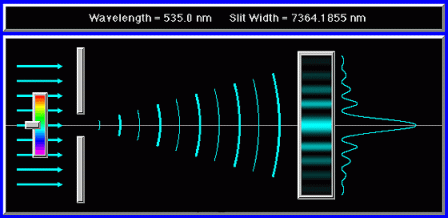Francesco Maria Grimaldi (continued)
Grimaldi should be credited not only with the discovery of the phenomenon, but also with the term used to describe it and a first attempt at interpreting it. In order to qualify the anomolous way in which light was propagated, which he discovered and described, Grimaldi coined the adverb "diffracte" (from the Italian meaning break or snap), while he inferred from the outcome of his experiments that "at least on some occasions" (saltem aliquando) light must propagate in a wave-like manner (undulatim).
In
general, diffraction means a deviation from the law of rectilinear propagation.
Such a deviation also takes place, in more elementary terms, when letting light cross
a slit some microns (a thousandth of a mm) wide.
A long time after
Grimaldi's discovery, diffraction was in fact interpreted in terms of a
wave-like conception of
light. It is actually the result of an interference between elementary waves
emitted -
in the case we are briefly discussing - by different points of the slit, more
pronounced as the dimensions of the slit become more comparable
with the wave length of
the light employed (the
range of wave lengths of
visible light is in the order of a fraction of micron).
| Fig. 1 : Diffraction from a slit.
Above is given the value of the wavelength of the
incident light and the slit width
(1 nm = 10-3 micron). The figure was obtained from
applet java: "Single-Slit
Diffraction". (Credit: Sergey Kiselev e Tanya Yanovski-Kiselev ) |
Grimaldi's treatise appeared in print in the very year in which Newton, aged 23, made the optical experiments, in particular on refraction, that made him deservedly famous. And Newton is likely to have been acquainted with it, since influences of the treatise on his own work have been noted. At any rate, Newton quoted De lumine in his Optics (published in 1704). However, since in the meantime he had adhered to the concept according to which light propagated in terms of corpuscles and not of waves, he looked for an explanation in terms of refractions and reflections taking place on the edges of the obstacles interposed on the light's path. And that notwithstanding the fact that Grimaldi had proved that diffraction did not depend on them. It was also as a consequence of Newton's authority that nobody spoke about diffraction again until, in 1818, the phenomenon, its interpretation and the term diffraction itself were circulated afresh by the French physicist Augustin Fresnel.
|
|
(Francesco Maria Grimaldi - page 3 of 3)
< Back |

